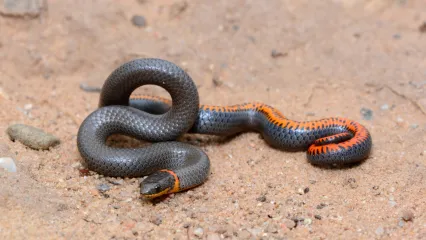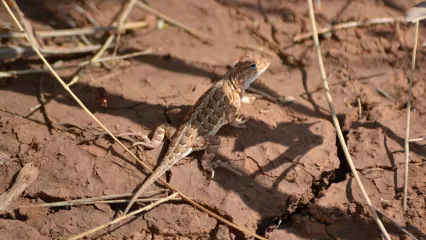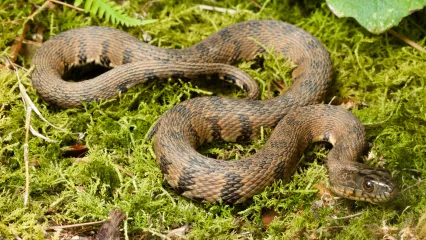
Description
Ring-necked snakes can be easily distinguished from all other snakes by a combination of small size; gray, olive, or nearly black dorsal surface; a belly that is yellow, orange, or red with one or more series of black spots; and a distinct complete or nearly complete orange to red ring behind the head extending from the ventral surface across most or all of the dorsal surface. The underside of the tail is usually red, often with a series of black markings along the edges. When disturbed, ring-necked snakes coil the tail, raise it off the ground and expose the brightly colored undersurface. Dorsal scales are smooth and the anal plate is divided. Ringed-neck snakes could be confused with the flat-headed snake, but flat-headed snakes have no neck ring, are lighter in color and have a pink belly with no spots.
Size
Adult ring-necked snakes vary from about 10-14 inches in total length. Hatchlings are 3-4 inches in total length.
Habitat
The distribution of ring-necked snakes in North America extends west to east across the entire United States and north to south from Canada in the east well into Mexico.
Life Cycle
Ring-necked snakes can be found in nearly every terrestrial habitat in Oklahoma. They are primarily day active and are often seen moving about in late morning or late afternoon. They are often common under surface objects during spring where they gain heat from rocks and other surface objects exposed to direct sun and where they find prey. Mating occurs in early spring and eggs are deposited in May and June. Hatchlings appear in August and September. Ring-necked snakes eat a variety of small invertebrates, but mostly earthworms. Larger individuals can eat small lizards and other snakes. Ring-necked snakes are harmless.
How To Observe
Because of their small size, ring-necked snakes can be difficult to observe while they are active. Even so, they can be easily observed by turning surface objects (boards, pieces of tin, cardboard, and flat rocks) early in spring when daytime temperatures are moderate and the sun is out. It is not uncommon to find several of these snakes under a single surface item. During the remainder of the year, these snakes can be difficult to observe. Occasionally they bask on pavement at the edge of roads during mid-morning and late afternoon.
(This profile was created by Dr. Laurie Vitt as part of a partnership between the Wildlife Department and the Sam Noble Oklahoma Museum of Natural History. It was funded as part of a larger grant to survey and inventory amphibians and reptiles of the Wildlife Management Areas of Oklahoma: T-35-P-1.)


